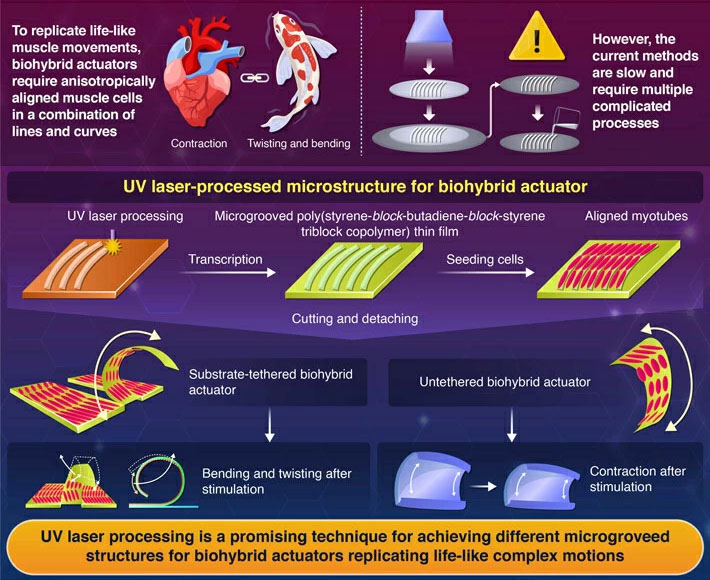| Feb 26, 2024 | |
Novel method for easy and quick fabrication of biomimetic robots with life-like movement |
|
| (Nanowerk News) Ultraviolet-laser processing is a promising technique for developing intricate microstructures, enabling complex alignment of muscle cells, required for building life-like biohybrid actuators, as shown by Tokyo Tech researchers. Compared to traditional complex methods, this innovative technique enables easy and quick fabrication of microstructures with intricate patterns for achieving different muscle cell arrangements, paving the way for biohybrid actuators capable of complex, flexible movements. | |
| Biomimetic robots, which mimic the movements and biological functions of living organisms, are a fascinating area of research that can not only lead to more efficient robots but also serve as a platform for understanding muscle biology. | |
| Among these, biohybrid actuators, made up of soft materials and muscular cells that can replicate the forces of actual muscles, have the potential to achieve life-like movements and functions, including self-healing, high efficiency, and high power-to-weight ratio, which have been difficult for traditional bulky robots that require heavy energy sources. | |
| One way to achieve these life-like movements is to arrange muscle cells in biohybrid actuators in an anisotropic manner. This involves aligning them in a specific pattern where they are oriented in different directions, like what is found in living organisms. | |
| While previous studies have reported biohybrid actuators with significant movement using this technique, they have mostly focused on anisotropically aligning muscle cells in a straight line, resulting in only simple motions, as opposed to the complex movement of native muscle tissues such as twisting, bending, and shrinking. Real muscle tissues have a complex arrangement of muscle cells, including curved and helical patterns. | |
| Creating such complex arrangements requires the formation of curved microgrooves (MGs) on a substrate, which then serve as the guide for aligning muscle cells in the required patterns. Fabrication of complex MGs has been achieved by methods such as photolithography, wavy micrography and micro-contact printing. However, these methods involve multiple intricate steps and are not suitable for rapid fabrication. | |
| To address this, a team of researchers from Tokyo Institute of Technology (Tokyo Tech) in Japan, led by Associate Professor Toshinori Fujie from the School of Life Science and Technology, has developed an ultraviolet (UV) laser-processing technique for fabricating complex microstructures. | |
| "Based on our previous prototypes, we hypothesized that biohybrid actuators using an SBS (hard rubber) thin film with arbitrary anisotropic MGs fabricated by a UV laser processing can control cellular alignment in an arbitrarily anisotropic direction to reproduce more life-like flexible movements," explains Dr. Fujie. | |
| Their study has been published in the journal Biofabrication ("UV laser-processed microstructure for building biohybrid actuators with anisotropic movement"). | |
 |
|
| A Novel Method for Easy and Quick Fabrication of Biomimetic Robots with Life-Like Movement. (Image: Tokyo Tech) | |
| The novel technique includes forming curved MGs on a polyimide through UV-laser processing, which are then transcribed onto a thin film made of SBS. Next, skeletal muscle cells called myotubes, found in living organisms, are aligned using the MGs to achieve an anisotropic curved muscle pattern. | |
| The researchers used this method to develop two different biohybrid actuators: one tethered to the glass substrate and the other untethered. Upon electrical stimulation, both actuators deformed through a twisting-like motion. Interestingly, the biohybrid actuator when untethered, transformed into a 3D free-standing structure, due to the curved alignment of myotubes like a native sphincter. | |
| "These results signify that compared to traditional methods, UV-laser con is a quicker and easier method for the fabrication of tunable MG patterns. This method raises intriguing opportunities for achieving more life-like biohybrid actuators through guided alignment of myotubes," remarks Dr. Fujie, emphasizing the potential of this innovative technique. | |
| Overall, this study demonstrates the potential of UV-laser processing for the fabrication of different anisotropic muscle tissue patterns, paving the way for more life-like biohybrid actuators capable of complex, flexible movements. |
| Source: Tokyo Tech (Note: Content may be edited for style and length) |
We curated a list with the (what we think) 10 best robotics and AI podcasts – check them out!
Also check out our Smartworlder section with articles on smart tech, AI and more.

